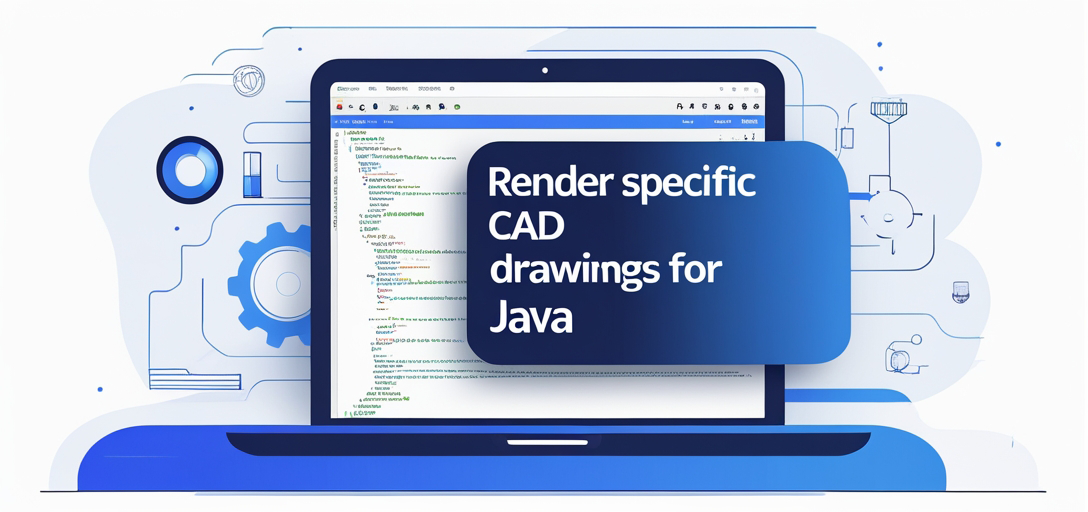How to Render Specific CAD Drawings in Java Using GroupDocs.Viewer
Introduction
Rendering specific layouts from CAD drawings is essential for focusing on particular design elements, enhancing visual presentations’ precision. This tutorial demonstrates how to extract and display designated sections of a CAD file using GroupDocs.Viewer for Java.

In this guide, you’ll learn:
- How to set up GroupDocs.Viewer for Java
- Steps to render specific layouts from CAD files
- Key configuration options and their purposes
- Troubleshooting tips for common issues
Prerequisites
Before rendering layouts, ensure you have the following:
Required Libraries, Versions, and Dependencies:
- GroupDocs.Viewer for Java: Version 25.2 or later.
- Maven to manage dependencies.
Environment Setup Requirements:
- A working Java Development Kit (JDK).
- Basic understanding of Java programming concepts.
Knowledge Prerequisites:
- Familiarity with CAD drawings, particularly DWG files.
- Comfortable using an Integrated Development Environment (IDE) like IntelliJ IDEA or Eclipse.
Setting Up GroupDocs.Viewer for Java
Add GroupDocs.Viewer as a dependency in your project using Maven:
<repositories>
<repository>
<id>repository.groupdocs.com</id>
<name>GroupDocs Repository</name>
<url>https://releases.groupdocs.com/viewer/java/</url>
</repository>
</repositories>
<dependencies>
<dependency>
<groupId>com.groupdocs</groupId>
<artifactId>groupdocs-viewer</artifactId>
<version>25.2</version>
</dependency>
</dependencies>
License Acquisition Steps:
- Free Trial: Obtain a free trial to explore features.
- Temporary License: Apply for extended access during development.
- Purchase: Acquire a full license for production use.
Implementation Guide
Follow these steps to render specific layouts from CAD drawings using GroupDocs.Viewer in Java:
Render a Specific Layout
Overview
This feature allows you to extract and display designated sections of a CAD file, focusing on particular design elements.
Step 1: Define Output Directory
Create an output directory for the rendered HTML files:
Path outputDirectory = Utils.getOutputDirectoryPath("YOUR_OUTPUT_DIRECTORY");
Explanation: The Utils.getOutputDirectoryPath method ensures your files are saved in the desired location.
Step 2: Configure Output Page Format
Set up naming for each rendered page:
Path pageFilePathFormat = outputDirectory.resolve("page_{0}.html");
Explanation: The {0} placeholder allows dynamic file naming, useful when rendering multiple layouts or pages.
Step 3: Set Up HtmlViewOptions
Configure HtmlViewOptions to specify how the CAD layout will be rendered:
HtmlViewOptions viewOptions = HtmlViewOptions.forEmbeddedResources(pageFilePathFormat);
Explanation: The forEmbeddedResources method ensures resources like images and styles are embedded within each HTML file, enhancing portability.
Step 4: Specify Layout Name
Indicate the layout you wish to render:
viewOptions.getCadOptions().setLayoutName("Model");
Explanation: Specifying “Model” directs GroupDocs.Viewer to focus on this particular layout, ignoring others.
Step 5: Render the Layout
Use a try-with-resources statement to manage the Viewer object:
try (Viewer viewer = new Viewer(TestFiles.SAMPLE_DWG_WITH_LAYOUTS_AND_LAYERS)) {
viewer.view(viewOptions);
}
Explanation: The view method processes the CAD file, rendering the specified layout as HTML files in your output directory.
Troubleshooting Tips
- Ensure all paths and filenames are correctly configured to avoid errors.
- Verify that the specified layout exists within the CAD file to prevent issues.
Practical Applications
Rendering specific layouts from CAD drawings has several real-world applications:
- Architectural Presentations: Display individual sections of a building plan for focused discussions.
- Manufacturing Prototypes: Highlight particular components in machinery designs during reviews.
- Educational Tools: Use isolated layers or views to explain complex concepts.
- Integration with Document Management Systems: Automatically extract and display specific layouts within workflows.
- Customized Reporting: Generate reports focusing on key design elements for project updates.
Performance Considerations
To ensure optimal performance:
- Optimize Resource Usage: Monitor memory usage during rendering, especially with large CAD files.
- Efficient Memory Management: Use Java’s garbage collection and resource management features effectively. Close resources like
Viewerinstances promptly after use.
Conclusion
You’ve mastered the basics of rendering specific layouts from CAD drawings using GroupDocs.Viewer for Java. This capability can streamline your workflow by allowing you to focus on particular design elements with precision.
Next Steps:
- Experiment with different layout names and configurations.
- Explore additional features offered by GroupDocs.Viewer, such as watermarking or converting formats.
We encourage you to try implementing this solution in your projects. For more detailed information, check the resources provided below.
FAQ Section
- What is GroupDocs.Viewer for Java?
- A powerful library designed to render documents and images across various formats, including CAD drawings.
- How do I obtain a temporary license for GroupDocs.Viewer?
- Visit GroupDocs’ purchase page and apply for a free temporary license.
- Can GroupDocs.Viewer handle large CAD files efficiently?
- Yes, it is optimized to manage large files but always monitor resource usage during rendering.
- What other document formats can I render with GroupDocs.Viewer?
- It supports numerous formats including PDF, Word, Excel, and images like PNG or JPEG.
- How do I troubleshoot rendering issues in CAD drawings?
- Verify your layout name, check file paths, and ensure that the CAD file contains the specified layout.